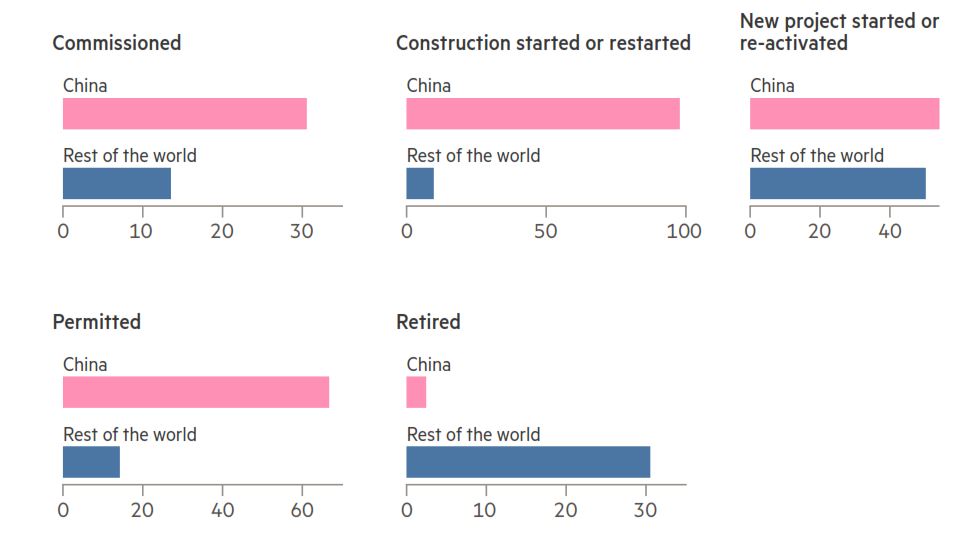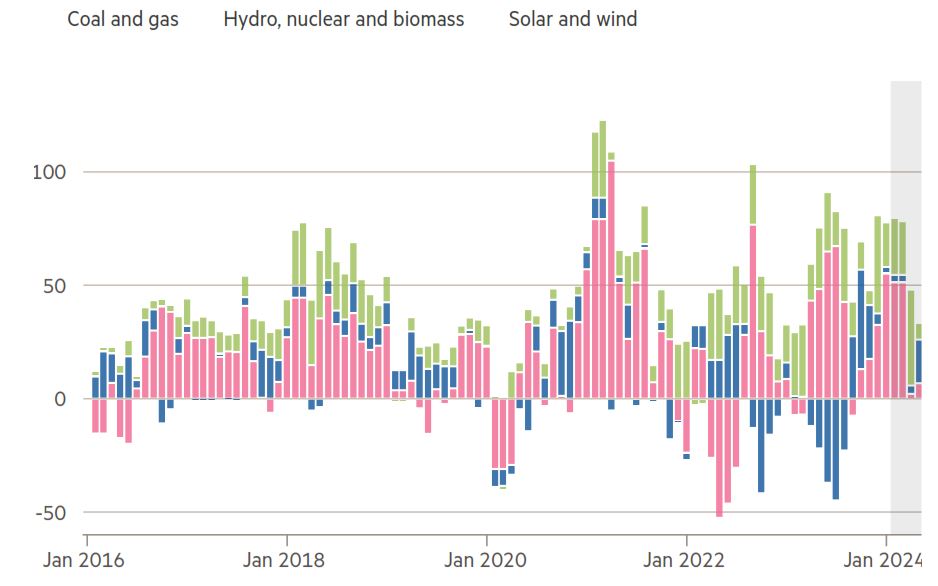
Report of 94.5GW of capacity being added last year undermines vow to start reducing carbon emissions by
2030.

Joe Leahy and Wenjie Ding in Beijing and Attracta Mooney in London
China’s coal plant construction surged last year to the highest level in almost a decade,
conflicting with President Xi Jinping’s promise that carbon emissions would peak
before 2030, researchers have said.
In a report released on Thursday, the think-tank Centre for Research on Energy and
Clean Air (Crea) and Global Energy Monitor (GEM) said that while China added a
record 356GW of wind and solar electricity-generating capacity in 2024, it also began
building coal power plants with 94.5GW of capacity, the most since 2015.
The new construction, as well as the resumption of suspended projects with another
3.3GW capacity, boosted coal’s role in the power system of the world’s second-largest
economy despite its push into renewables, the report said.
“Instead of replacing coal, clean energy is being layered on top of an entrenched reliance
on fossil fuels,” said the report, which was lead authored by Qi Qin, China analyst at the
Helsinki-based Crea, and Christine Shearer of California-based GEM. “The parallel
expansion of coal and renewables risks undermining China’s clean energy transition.”
China continues to substantially expand new coal-fired electricity generating capacity
Change of status in coal power pipeline (GW), 2024

China is the world’s biggest emitter of greenhouse gases, accounting for about 30 per
cent of the global total.
But it is also rapidly developing renewable energy — its expansion of wind and solar
energy capacity last year was nearly equivalent to the total installed in the US. Xi has
pledged the country will reach peak carbon dioxide emissions before 2030 and net zero
emissions by 2060.
“China has always been a doer in climate response and is firmly committed to green and
low-carbon development,” said a senior Chinese official. “Our carbon emissions
intensity has kept decreasing, the share of non-fossil fuel in total energy consumption
has steadily increased.”
But the Crea and GEM report argued that structural factors in China’s power generation
industry meant the surge in coal plants could impede the transition to renewable
energy.
Electricity buyers were locked into long-term coal power purchasing agreements that
penalised them if they fail to buy contracted volumes. This discouraged them from
prioritising clean energy, the report said.
Coal mining companies were also funding 75 per cent of newly approved coal power
capacity, driving new projects even “when market fundamentals do not justify it”, the
report said.
“Coal and clean energy are increasingly competing for space in China’s power system. In
the fourth quarter of 2024, despite slowing electricity demand growth, fossil fuel
generation remained high, while solar and wind utilisation dropped sharply,” the report
said.
Clean energy accounted for most of the growth in Chinese electricity generation in , but fossil fuel use also expanded in most months
Monthly growth of power generation (TWh), year on year, by source

Other analysts said that part of the reason China was building more coal plants could be
its lack of a unified national market.
This meant different regions built their own coal plants to provide local “load following”
— power used to balance out fluctuations from renewables — potentially creating
capacity that would not be needed if there was a national market.
Coal plants and renewables had different economics, the analysts said. Coal plants often
received “capacity payments” for being read to make electricity available to the grid to
back up renewables.
“For the most part, coal competes with other coal,” said David Fishman, senior manager
at the Lantau Group, a consultancy.
Fishman said China’s coal plant fleet was operating at about 50 per cent capacity.
Construction of more coal-fired power stations would “on the whole” mean lower use of their capacity, he said.